| View previous topic :: View next topic |
| Author |
Message |
Doc Sharptail


Joined: 23 Nov 2020
Posts: 987
Location: Winnipeg Canada
|
 Posted: Thu Sep 01, 2022 5:08 pm Post subject: Posted: Thu Sep 01, 2022 5:08 pm Post subject: |
 |
|
Doc Sharptail wrote:
There were match needle metering finders for the Nikon F-2, which are by far the most common, and were slightly cheaper.
It is still my preferred nikon finder.
The M/D-4 for the F-3 may have been an ergonomic wonder, but it sure was not a fully thought-out design.
There was no such thing as taking the winder off mid-roll. It could be done with a changing bag- otherwise the film on the take up spool would be re-exposed. The thread-in motor drive cap on the camera body was a poorly conceived work-around.
Mine with full battery pack made for a heavy, and bulky camera.
I really don't miss the F-3 at all.
-D.S.
_________________
D-810, F2, FTN.
35mm f2 O.C. nikkor
50 f2 H nikkor, 50 f 1.4 AI-s, 135 f3.5 Q,
50 f2 K nikkor 2x, 28-85mm f3.5-4.5 A/I-s, 35-105 3.5-4.5 A/I-s, 200mm f4 Micro A/I, partial list.
"Ain't no half-way" -S.R.V.
"Oh Yeah... Alright" -Paul Simon |
|
| Back to top |
|
 |
stevemark

Joined: 29 Apr 2011
Posts: 3754
Location: Switzerland
|
 Posted: Thu Sep 01, 2022 6:21 pm Post subject: Posted: Thu Sep 01, 2022 6:21 pm Post subject: |
 |
|
stevemark wrote:
@ cooltouch:
Thanks a lot for - again! - sharing your vast experience. It's always a joy to read your stories, and I hope you'll continue  . .
Sadly, I'm too "young" to have real experience with these most beautiful SLRs from the 1970s and early 1980s. Back then when the New F-1 came out I was barely 12 years old, and using my father's Mamiya ZE ... the only "real" thing back then were the advertising brochures for the New F-1 and the Leica M6, which I both kept with me all the time (and especially during boring high school lessons)! The brochure for the Nikon F3 didn't really convince me, and so I never really thought of getting one when I was 16 (and considering buying my first professional SLR) ...
Of course these days I can play with all those nice SLRs, but your experience is way more profound - either having used them as a professional photographer, or having sold them as a camera dealer.
Thanks again!
S
_________________
www.artaphot.ch |
|
| Back to top |
|
 |
cooltouch


Joined: 15 Jan 2009
Posts: 9097
Location: Houston, Texas
|
 Posted: Fri Sep 02, 2022 2:13 am Post subject: Posted: Fri Sep 02, 2022 2:13 am Post subject: |
 |
|
cooltouch wrote:
Thanks for the kind words, Steve. Back in the 80s, when I was most heavily involved with Canon gear, my chosen cameras were 10 years old or more. My first F-1 was the first version, and I bought it because of positive experiences I had with an FTb. I bought it used, and it looked like it had seen hard duty as a hockey puck. But everything worked and continued to work for as long as I owned it. I bought my first F2 in 1989, and it was a "71", so it was almost 20 years old. I still own that camera, and like the F-1, it has never missed a lick. So I guess what I'm saying is, I wasn't playing with cutting-edge gear either. If anything, I was being intentionally anachronistic.
Doc, when I refer to "match needle metering" I'm referring to a specific metering type, where two needles are brought together to indicate correct exposure, such as is found on the Canon FTb, F-1, Pentax KX, Nikon FE, and others. I too own a couple of F2 DP-1 finders, but they have a single needle that is centered to indicate correct exposure. In the end, both systems accomplish the same thing. For me, I think it's what I got used to early on, and I just preferred to stick with it.
The F3 was hardly the only camera that couldn't have the motor removed mid-roll without exposing the film. With the original Canon F-1, the entire bottom plate of the camera had to be removed to mount the motor. And the New F-1 didn't fare much better. It's been quite a while since I've removed the drive from my New F-1, but as I dimly recall, there are at least three caps that must be removed to mount the drive, so chances are it wouldn't survive that test, either. But I don't recall ever having a situation where I needed to remove any drive mid-roll anyway, so that's been a non-issue for me. In terms of motor drives in general, when it comes to simplicity of use, I find the Nikon MD12 and I believe also the Minolta MD-1 to be really hard to beat. Just mount and go. Canon's MD MA (for the A-1 and AE-1 Program) is almost as easy, but it's a two-step process to mount and dismount that drive.
Heh, I've never regarded the F3 with MD4 as a heavyweight. Not after spending many a day with an old F-1 with motor slung around my neck.
_________________
Michael
My Gear List: http://michaelmcbroom.com/photo/gear.html
My Gallery: http://michaelmcbroom.com/gallery3/index.php/
My Flickr Page: https://www.flickr.com/photos/11308754@N08/albums
My Music: https://soundcloud.com/michaelmcbroom/albums
My Blog: http://michaelmcbroom.com/blogistan/ |
|
| Back to top |
|
 |
Doc Sharptail


Joined: 23 Nov 2020
Posts: 987
Location: Winnipeg Canada
|
 Posted: Fri Sep 02, 2022 7:51 am Post subject: Posted: Fri Sep 02, 2022 7:51 am Post subject: |
 |
|
Doc Sharptail wrote:
| cooltouch wrote: |
Doc, when I refer to "match needle metering" I'm referring to a specific metering type, where two needles are brought together to indicate correct exposure, such as is found on the Canon FTb, F-1, Pentax KX, Nikon FE, and others. I too own a couple of F2 DP-1 finders, but they have a single needle that is centered to indicate correct exposure. In the end, both systems accomplish the same thing. For me, I think it's what I got used to early on, and I just preferred to stick with it.
The F3 was hardly the only camera that couldn't have the motor removed mid-roll without exposing the film. With the original Canon F-1, the entire bottom plate of the camera had to be removed to mount the motor. And the New F-1 didn't fare much better. It's been quite a while since I've removed the drive from my New F-1, but as I dimly recall, there are at least three caps that must be removed to mount the drive, so chances are it wouldn't survive that test, either. But I don't recall ever having a situation where I needed to remove any drive mid-roll anyway, so that's been a non-issue for me. In terms of motor drives in general, when it comes to simplicity of use, I find the Nikon MD12 and I believe also the Minolta MD-1 to be really hard to beat. Just mount and go. Canon's MD MA (for the A-1 and AE-1 Program) is almost as easy, but it's a two-step process to mount and dismount that drive.
Heh, I've never regarded the F3 with MD4 as a heavyweight. Not after spending many a day with an old F-1 with motor slung around my neck. |
The M/D-12 and FM/Fe is a very versatile combination.
The old 12 is still my favorite drive, even though a bit on the slow side.
That is actually one of the lighter drives to come down the photographic pike.
I actually "grew up" on the nikkormat FT series metering needle systems, so the similar display in the DP finders was no great hurdle.
I used an FE for quite a few years, and it is one of the better metering displays that I've used.
I still have an intense dislike of red l.e.d.'s in a camera viewfinder, so the FM series I've always passed on.
All my FE's are gone now. I gave the last to my sister, whose Canon AE-1 died electronically.
From my personal experience, the FE is a much better long term survivor than the FE-2.
The collection is now pared down to a mint Nikkormat FTN, a good condition nikkormat FT-2, and a mint chrome F-2.
That's down quite a bit from what was clogging the closet...
The F-3's 80-20 center weighting was one of the things that led to it's purchase for me.
I have come to believe that as technically good as the F-3 was, it simply wasn't the camera for me.
I hope whoever ended up with my old F-3 and drive gets as much use and enjoyment out of it as possible.
My personal slr Nirvana is still the F-2, warts and all 
-D.S.
_________________
D-810, F2, FTN.
35mm f2 O.C. nikkor
50 f2 H nikkor, 50 f 1.4 AI-s, 135 f3.5 Q,
50 f2 K nikkor 2x, 28-85mm f3.5-4.5 A/I-s, 35-105 3.5-4.5 A/I-s, 200mm f4 Micro A/I, partial list.
"Ain't no half-way" -S.R.V.
"Oh Yeah... Alright" -Paul Simon |
|
| Back to top |
|
 |
Alun Thomas

Joined: 20 Aug 2018
Posts: 628
Location: New Zealand
|
 Posted: Wed Sep 14, 2022 8:14 pm Post subject: Posted: Wed Sep 14, 2022 8:14 pm Post subject: |
 |
|
Alun Thomas wrote:
#1

#2

One of the lesser known DKL leaf shutter cameras, this one has a working shutter but a dead meter. I was thinking of trying a repair, but usually my nerves fail me on anything rare or valuable. |
|
| Back to top |
|
 |
stevemark

Joined: 29 Apr 2011
Posts: 3754
Location: Switzerland
|
 Posted: Sat Sep 17, 2022 10:19 am Post subject: Posted: Sat Sep 17, 2022 10:19 am Post subject: |
 |
|
stevemark wrote:
| Alun Thomas wrote: |
One of the lesser known DKL leaf shutter cameras, this one has a working shutter but a dead meter. I was thinking of trying a repair, but usually my nerves fail me on anything rare or valuable. |
Never heard of the "Edixa Electronica"! Thanks for sharing 
S
Yep, I too prefer to try to repair only common stuff, not the rarities ...!
_________________
www.artaphot.ch |
|
| Back to top |
|
 |
titrisol70


Joined: 14 Dec 2021
Posts: 149
Location: State of Denial
|
 Posted: Sat Sep 17, 2022 1:00 pm Post subject: Ambi Silette Posted: Sat Sep 17, 2022 1:00 pm Post subject: Ambi Silette |
 |
|
titrisol70 wrote:
I learned abut this camera in the early 2000s and was curious about it. The lines for 35-50-90mm lenses are bright and work great.
Here is with the 130/4 Telinear lens that needs a special viewfinder

Ambi-Silette and 130/4 |
|
| Back to top |
|
 |
titrisol70


Joined: 14 Dec 2021
Posts: 149
Location: State of Denial
|
 Posted: Wed Nov 02, 2022 1:01 pm Post subject: Spotmatic F Posted: Wed Nov 02, 2022 1:01 pm Post subject: Spotmatic F |
 |
|
titrisol70 wrote:
After several years of negotiating my father in law agreed to pass-on his SP-F
He bought it new in the mid70s and has used it a lot, has some lovely brassing
The 35/3.5 is a wonderful piece of glass!
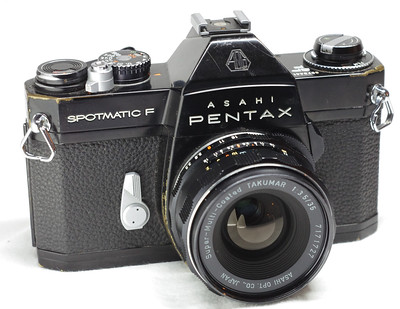 |
|
| Back to top |
|
 |
ZuikosHexanonsandVivitars


Joined: 03 Nov 2021
Posts: 223
Location: Austria
|
 Posted: Thu Nov 17, 2022 4:37 pm Post subject: Posted: Thu Nov 17, 2022 4:37 pm Post subject: |
 |
|
ZuikosHexanonsandVivitars wrote:
My OM-2N and the two silver noses I own.

_________________
Cheers, Gerhard |
|
| Back to top |
|
 |
ZuikosHexanonsandVivitars


Joined: 03 Nov 2021
Posts: 223
Location: Austria
|
 Posted: Thu Nov 17, 2022 5:04 pm Post subject: Posted: Thu Nov 17, 2022 5:04 pm Post subject: |
 |
|
ZuikosHexanonsandVivitars wrote:
This OM-2SP ate batteries like candies, luckily of the LR-44 type. So supply is still good, I might try a color negative film with it once the Ilford in the OM-3 is spent. I bought this camera in the 90s, when everybody was keen on autofocus, for very little money.
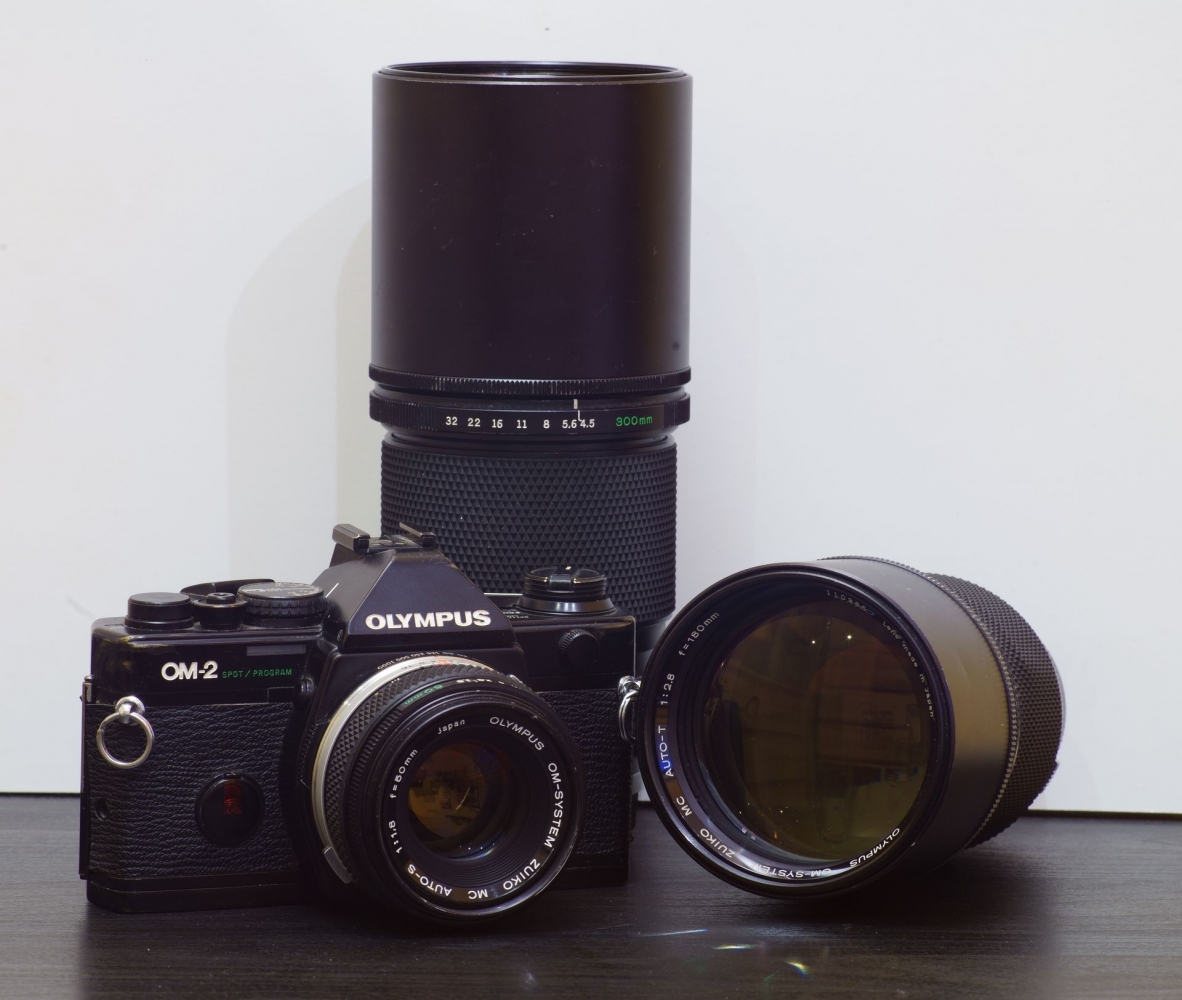
_________________
Cheers, Gerhard |
|
| Back to top |
|
 |
ZuikosHexanonsandVivitars


Joined: 03 Nov 2021
Posts: 223
Location: Austria
|
 Posted: Thu Nov 17, 2022 5:33 pm Post subject: Posted: Thu Nov 17, 2022 5:33 pm Post subject: |
 |
|
ZuikosHexanonsandVivitars wrote:
My Konica Autoreflex TC. It misses some of the features of the Autoreflex T and T3, but it is in weight and size comparable to an Olympus body. According to konicafiles.com, TC´s with capital written "KONICA" were the first version and produced from early 1976 until September 1977, and about serial number 380.000 the inscription on the viewfinder changed to small letters after the K. This camera has production number 378.324.
| stevemark wrote: |
The camera - even though marked "Porst" - is a Fujica STX-1. It's a fully mechanical SLR with a limited set of shutter speeds from 1/2s to 1/700s, somehow similar to the ubiquitous Konica TC (which goes from 1/1000s to 1/15s). The Fuji however has a horizontal cloth shutter, while the Konica has a vertical metal shutter.
S |
Steve, from your post about the Porst: the TC goes down to 1/8sec exposure time - and there´s still "B" 

_________________
Cheers, Gerhard |
|
| Back to top |
|
 |
stevemark

Joined: 29 Apr 2011
Posts: 3754
Location: Switzerland
|
 Posted: Tue Nov 22, 2022 7:31 pm Post subject: Posted: Tue Nov 22, 2022 7:31 pm Post subject: |
 |
|
stevemark wrote:
| ZuikosHexanonsandVivitars wrote: |
My OM-2N and the two silver noses I own.
|
A very nice camera for sure! Sadly the Zuiko lenses are quite scarce here in Switzerland (apart from ubiquituous 1.8/50, 3.5/28 and 3.5/135 Zuikos), and in addition tho the 1.8/50 and the 3.5/28 I only have a 3.5/21, the 1.4/50, the 2.8/135 and the 4.5/300 (plus a few zooms).
| ZuikosHexanonsandVivitars wrote: |
This OM-2SP ate batteries like candies, luckily of the LR-44 type. So supply is still good, I might try a color negative film with it once the Ilford in the OM-3 is spent. I bought this camera in the 90s, when everybody was keen on autofocus, for very little money.
|
OM-3 and 2.8/180 ... what a beautiful combination! I've never seen a 2.8/180, and i would love to see how it performs since its construction is a bit different from most other fast 180mm / 200mm lenses.
| ZuikosHexanonsandVivitars wrote: |
Steve, from your post about the Porst: the TC goes down to 1/8sec exposure time - and there´s still "B" 
|
OUCH. Thanks for correcting my mistake. I actually never really took pictures with a Konica TC, even though I have several samples (both "KONICA" and "Konica"). While mechanical SLR usually have a reputation of being reliable and sturdy, most of my T / T2 / T3 Konicas have some issues, usually a blocked shutter. Later T-3N / T4 / TC models seem to be more reliable, but the "newest" Konica SLRs again often have some issues.
S
_________________
www.artaphot.ch |
|
| Back to top |
|
 |
starbucklover69
Joined: 27 Nov 2022
Posts: 42
Location: Swiss
|
 Posted: Sun Nov 27, 2022 5:43 pm Post subject: Posted: Sun Nov 27, 2022 5:43 pm Post subject: |
 |
|
starbucklover69 wrote:
This is my little Olympus Pen F Collection.
With Pen FT in Chrome and beauty Black Version and Lenses 20mm f3.5 , 25 f2.5 , 38 f1.8 , 40 f1.4 , 42 f1.2 , 60 f1.5 , 70 f2 , 100 f3.5 , 150 f4 , 250 f5 and the 50-90 f3.5 Zoom.
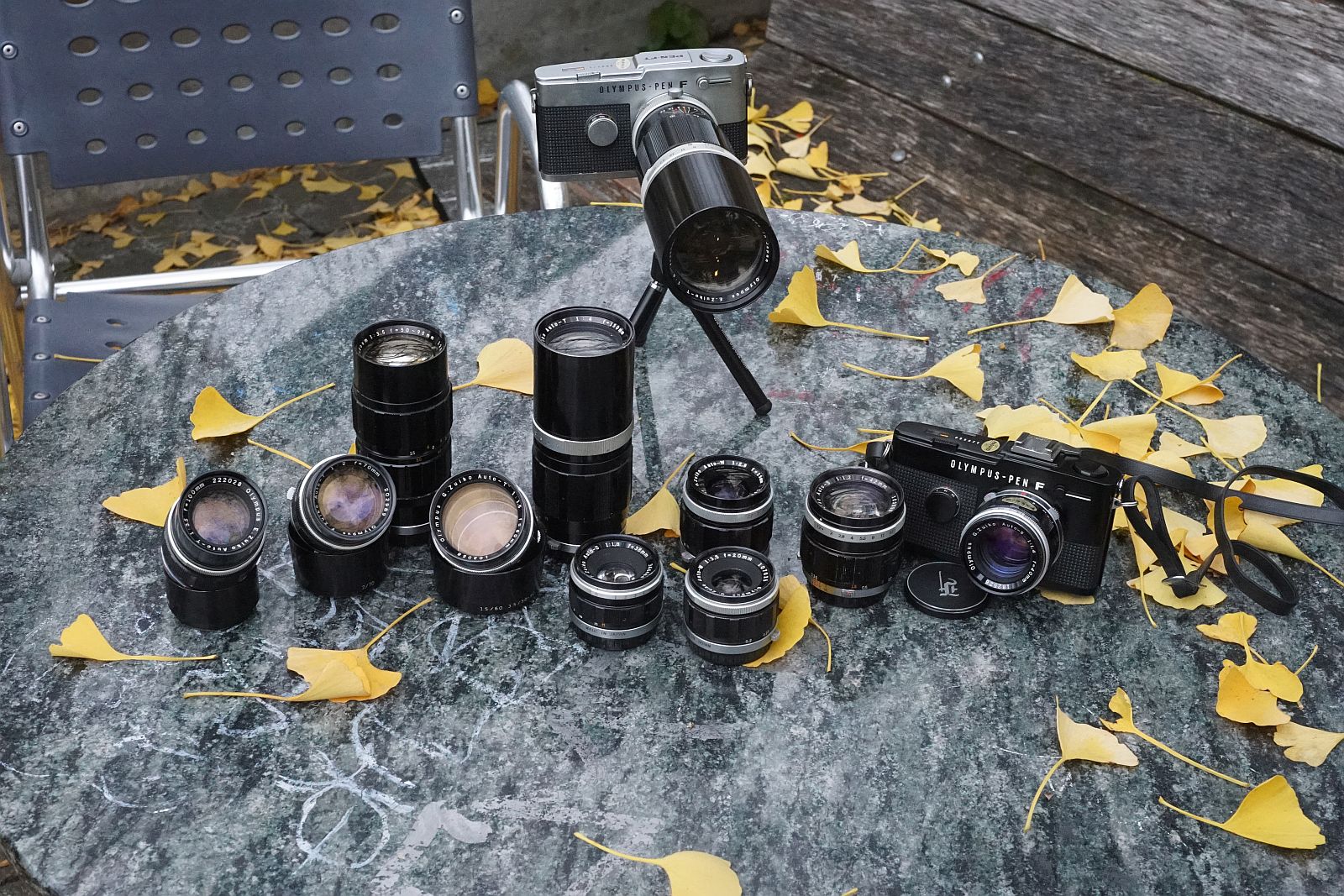
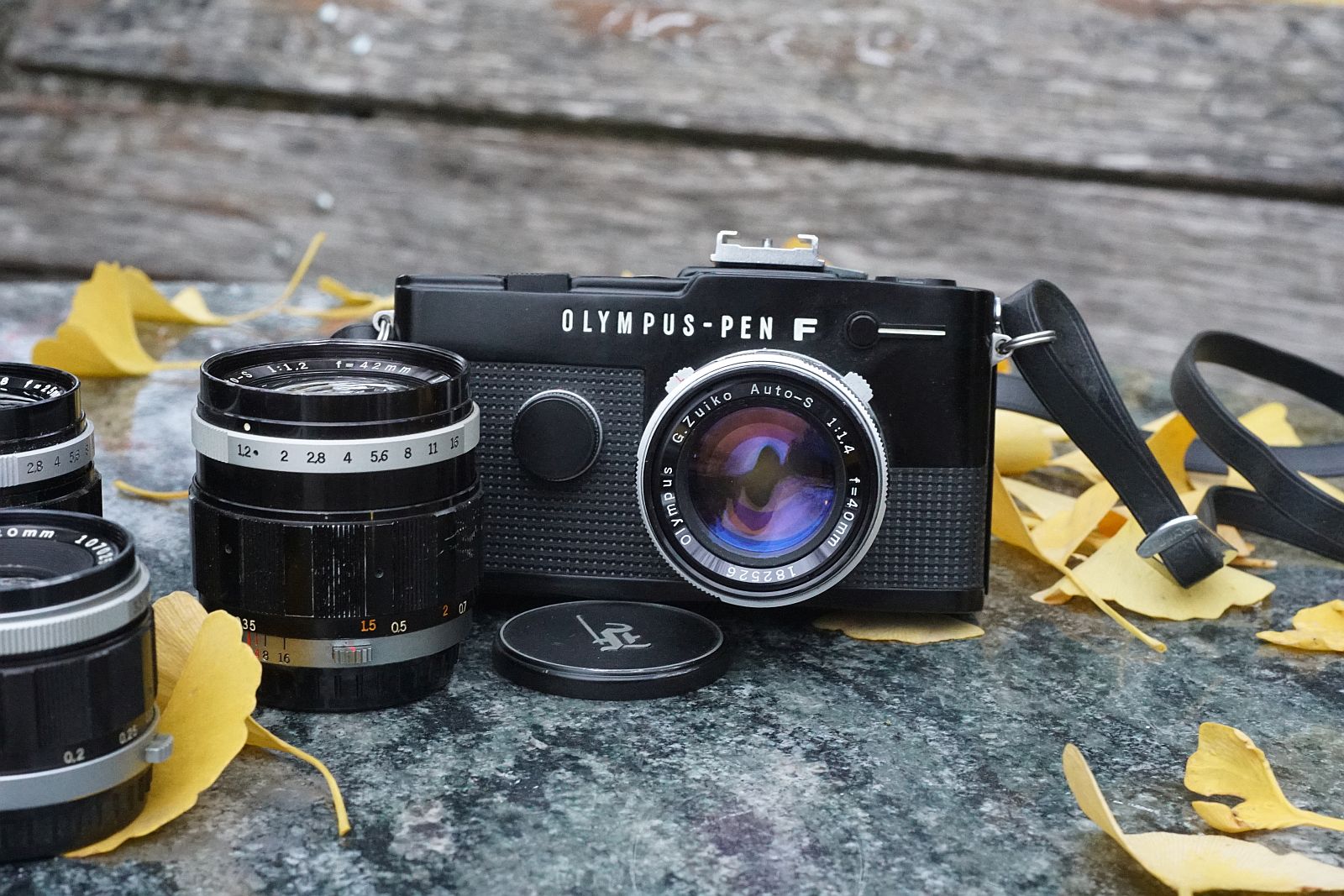
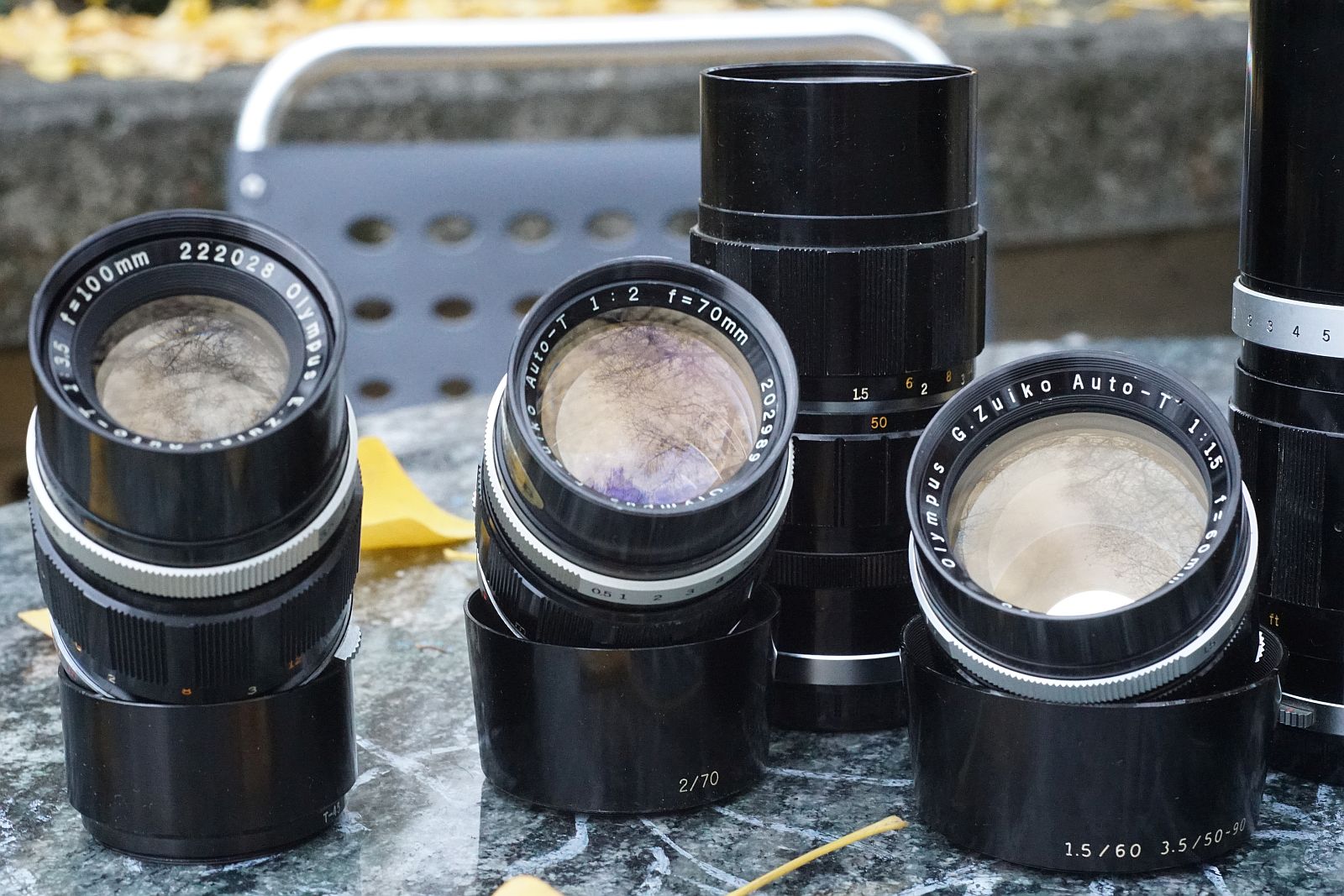
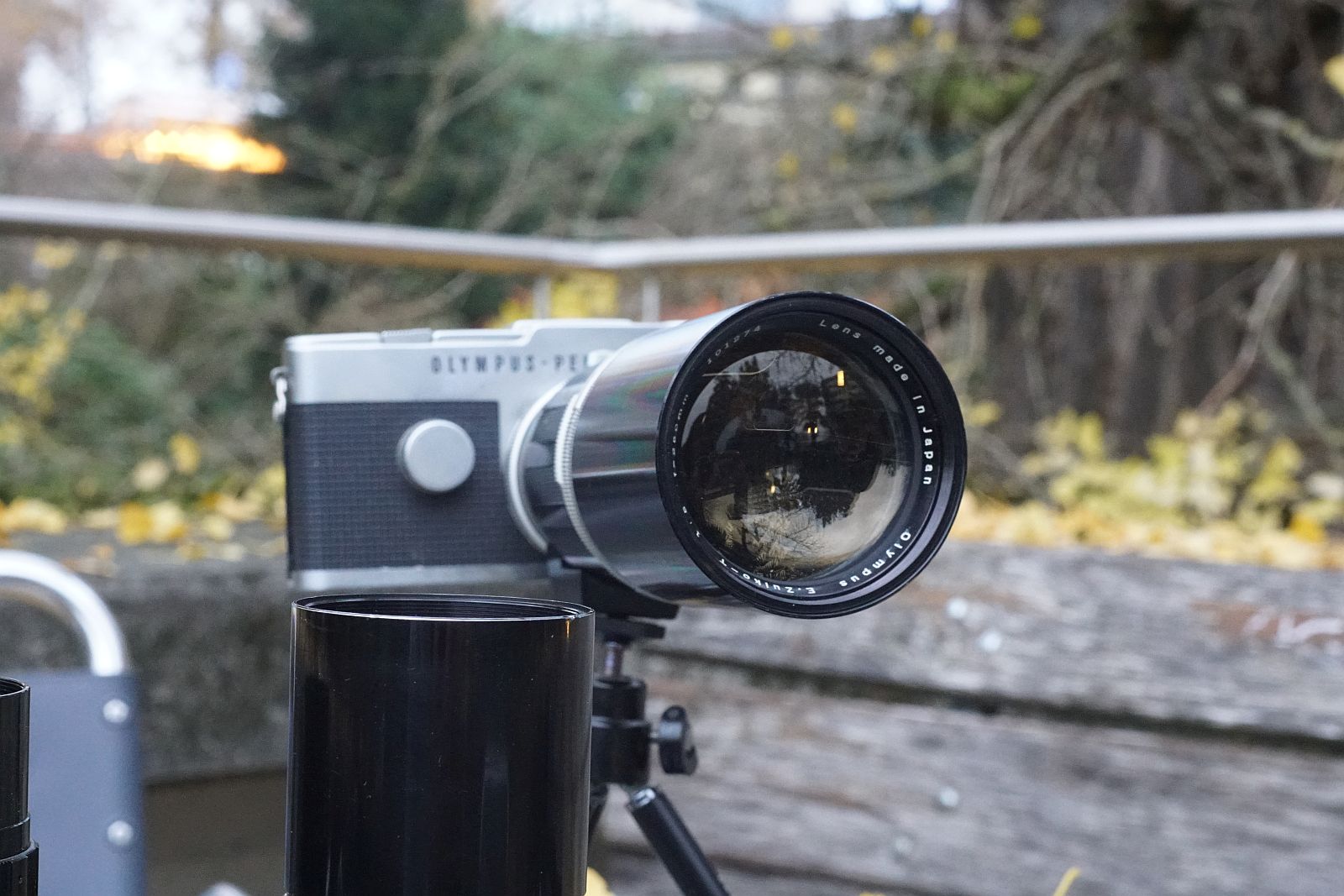 |
|
| Back to top |
|
 |
55


Joined: 13 May 2013
Posts: 709
Location: U.S.
Expire: 2022-06-15
|
 Posted: Tue Nov 29, 2022 5:21 pm Post subject: Posted: Tue Nov 29, 2022 5:21 pm Post subject: |
 |
|
55 wrote:
| starbucklover69 wrote: |
This is my little Olympus Pen F Collection.
. . . |
Welcome, starbucklover69. That's a nice presentation of a beautiful collection!
I know little about Olympus Pen F, but I'm guessing it took you a long time to assemble your horde?
Which item was the most difficult to obtain? |
|
| Back to top |
|
 |
starbucklover69
Joined: 27 Nov 2022
Posts: 42
Location: Swiss
|
 Posted: Tue Nov 29, 2022 5:56 pm Post subject: Posted: Tue Nov 29, 2022 5:56 pm Post subject: |
 |
|
starbucklover69 wrote:
| 55 wrote: |
| starbucklover69 wrote: |
This is my little Olympus Pen F Collection.
. . . |
Welcome, starbucklover69. That's a nice presentation of a beautiful collection!
I know little about Olympus Pen F, but I'm guessing it took you a long time to assemble your horde?
Which item was the most difficult to obtain? |
The 40 f1.4 and the 60 f1.5. I found the 42mm 10 years ago for 20 Swiss francs. I have been searching and collecting the Pen f series ever since. I exchanged the 60mm for 6 Minolta x700 with lenses. I ordered the PenF-Mft adapter. Comes in mid-December. I already have the adapter for the Sony. |
|
| Back to top |
|
 |
starbucklover69
Joined: 27 Nov 2022
Posts: 42
Location: Swiss
|
 Posted: Tue Nov 29, 2022 5:58 pm Post subject: Posted: Tue Nov 29, 2022 5:58 pm Post subject: |
 |
|
starbucklover69 wrote:
| 55 wrote: |
| starbucklover69 wrote: |
This is my little Olympus Pen F Collection.
. . . |
Welcome, starbucklover69. That's a nice presentation of a beautiful collection!
I know little about Olympus Pen F, but I'm guessing it took you a long time to assemble your horde?
Which item was the most difficult to obtain? |
Here is a german Site for the Pen F. https://olypedia.de/index.php?title=Kategorie:PEN_F_System |
|
| Back to top |
|
 |
55


Joined: 13 May 2013
Posts: 709
Location: U.S.
Expire: 2022-06-15
|
 Posted: Wed Nov 30, 2022 5:01 pm Post subject: Posted: Wed Nov 30, 2022 5:01 pm Post subject: |
 |
|
55 wrote:
| starbucklover69 wrote: |
. . .
The 40 f1.4 and the 60 f1.5. I found the 42mm 10 years ago for 20 Swiss francs. I have been searching and collecting the Pen f series ever since. . . |
 I know how rewarding it is to find an item after a long search. I know how rewarding it is to find an item after a long search.
Thank you. I never knew there were so many lenses for Pen F. |
|
| Back to top |
|
 |
Alun Thomas

Joined: 20 Aug 2018
Posts: 628
Location: New Zealand
|
 Posted: Fri Dec 02, 2022 12:00 am Post subject: Posted: Fri Dec 02, 2022 12:00 am Post subject: |
 |
|
Alun Thomas wrote:

These two cameras are both rebadged Petri cameras, marketed by Ihagee West, after they won a court case with the East German company of the same name. Their first release was the Exakta Real, using a new bayonet mount. Following that was the Twin TL, a Cosina Hi-Lite rebadge, still using the new mount. Then it was released in M42, and then following that, these two Petri cameras, based on the Petri 1/1000s M42 chassis, were released. The 55/1.8 lens on the left is a Petri made lens with a decent reputation. The one on the right looks to be made by Sankor, possibly based on previous 55/1.4 designs from other manufacturers.
The cameras are almost identical apart from the omission of the 1/1000s speed and the timer from the left hand camera. Actually there is a further difference, in the metering system. On the TL-500, the metering works anytime the stop down button is used, exactly the same as any other M42 stop down camera from that period. On the TL-1000, the meter turns on when the camera shutter is cocked, and off when the shutter is released. This setup was first featured on the Petriflex 7 camera, and is retained here. You still have to stop down manually with the same lever as on the TL-500.
This caused me some confusion when I received the TL-1000, I though the meter was defective. When I took the top cover off to try and fix the perceived 'fault', I noticed the camera is quite nicely made, despite the lowly reputation (not) enjoyed by Petri cameras. |
|
| Back to top |
|
 |
stevemark

Joined: 29 Apr 2011
Posts: 3754
Location: Switzerland
|
 Posted: Sat Feb 11, 2023 9:45 pm Post subject: Minolta Dynax 7D Posted: Sat Feb 11, 2023 9:45 pm Post subject: Minolta Dynax 7D |
 |
|
stevemark wrote:
Today I got another Minolta Dynax 7D, together with the iconic Minolta AF 2.8/28-70mm G lens (not shown here). The "D7D", as she was known in Europe, was Minoltas first "real" DSLR, and she sold in truckloads, at least here in Switzerland. At around CHF 3000.-- the camera was quite expensive, but that was kind of "normal" back then. Everyone was jumping on the DSLR bandwagon, including Minolta, finally. They were quite late since their the CEO had determined, in the mid-1990s, that "digital" would remain a niche market and APS would be the "next big thing". Of course the market wasn't inclined to obey him, but - to save face - he couldn't immediately change his assessment when "digital" became ubiquituous. The Minolta engineers were pretty upfront, but they were banned to put their high-tech into a decent SLR. First the very expensive digital stuff was put into one of the cheapest plastic Minolta bodies (instead of the beautiful Dynax/Alpha 9); later on they - at least - managed to put it into a excellent "bridge" camera with a 28-200mm (eqiv) fast zoom. Its last incarnation - the Minolta Dimage A2 and A200 - had a full metal body, 8 MP (quite a feat in early 2004), a 2.8-3.5/28-200mm (equiv) APO zoom lens and, last but not least, an integrated antishake mechanism.
Back to the Minolta Dynax 7D. Announced pretty early (remember: Minolta was late), it hit the market at the end of 2004. I got one of the first cameras then, and it had a HUGE flaw: The sensor was slightly tilted - which resulted in images either sharp at the top OR at the bottom, but not both (unless you stopped down to f16 or f22). Bummer ... turns out it wasn't Minoltas error, but Sonys: They had glued the sensor with uneven amounts of glue onto the base, thus resulting in a "tilted" sensor ... Apart from that issue (which was solved within a few weeks) the camera was an immediate success. Mine paid off completely with the very first assigment i had, and soon some nice lenses were following.

Here's an image of two samples of the Dynax (Maxxum) 7D - one with and one without the power grip. For a prosumer camera, the D7D was incredibly well made: Full metal body, and lots and lots and lots of dedicated buttons, sliders and switches. More on that later - first two more images of the camera itself:

Here it is shown with the Minolta 3.5-4.5/24-105mm standard zoom. It was a "analog" lens, but quite well suited for the 6MP sensor of the Dynax 7D.

_________________
www.artaphot.ch |
|
| Back to top |
|
 |
Doc Sharptail


Joined: 23 Nov 2020
Posts: 987
Location: Winnipeg Canada
|
 Posted: Sun Feb 12, 2023 5:15 pm Post subject: Posted: Sun Feb 12, 2023 5:15 pm Post subject: |
 |
|
Doc Sharptail wrote:
The Konica/Minolta badging is seldom seen here.
Odd that there were problems mounting the Sony sensor- likely a manufacturing floor problem.
Still a bit strange for someone with Sony's long term video sensor experience to not specify mounting procedures.
I wonder how corporate relations were before Sony took over.
-D.S.
_________________
D-810, F2, FTN.
35mm f2 O.C. nikkor
50 f2 H nikkor, 50 f 1.4 AI-s, 135 f3.5 Q,
50 f2 K nikkor 2x, 28-85mm f3.5-4.5 A/I-s, 35-105 3.5-4.5 A/I-s, 200mm f4 Micro A/I, partial list.
"Ain't no half-way" -S.R.V.
"Oh Yeah... Alright" -Paul Simon |
|
| Back to top |
|
 |
55


Joined: 13 May 2013
Posts: 709
Location: U.S.
Expire: 2022-06-15
|
 Posted: Sun Feb 12, 2023 5:21 pm Post subject: Posted: Sun Feb 12, 2023 5:21 pm Post subject: |
 |
|
55 wrote:
| Alun Thomas wrote: |
These two cameras are both rebadged Petri . . . |
| stevemark wrote: |
| Today I got another Minolta Dynax 7D . . . |
Interesting historical information! |
|
| Back to top |
|
 |
stevemark

Joined: 29 Apr 2011
Posts: 3754
Location: Switzerland
|
 Posted: Mon Feb 13, 2023 10:45 pm Post subject: Posted: Mon Feb 13, 2023 10:45 pm Post subject: |
 |
|
stevemark wrote:
| 55 wrote: |
| Alun Thomas wrote: |
These two cameras are both rebadged Petri . . . |
| stevemark wrote: |
| Today I got another Minolta Dynax 7D . . . |
Interesting historical information! |
Mainly based on discussions with the editor of "Sony Fotospiegel" (formerly "Minolta Fotospiegel") around 2008-2012, when I regularly did contribute to that magazine  . The said editor had been in close contact with Minolta Japan since the mid-1970s. So he knew quite a few "inside" stories . The said editor had been in close contact with Minolta Japan since the mid-1970s. So he knew quite a few "inside" stories 
Back to the D7D and its user interface - probably the best of any DSLR Im aware of. While it may look complicated at the beginning, it allows for direct control of all the essential functions without divinginto the menu (or sub-menu). Really impressive, and probably incredibly expensive to manufacture. Well, the D7D was "Malaysia", not "Japan", so ....
I always thought that all functions influencing the RAW data should be accessible directly (is without going into the menu). THe D7D is the only camera I'm aware of allowing this.
Here's the traditional "M-S-A-P" knob, allowing to select the respective mode. In addition there's the "green P" mode (everything including white balance is automatic), and three programmable modes "1-2-3". Nothing unusual here.
But then there's the selector for the white balance. Quite unusual and very useful - direct access to automatic WB, programmed WB (such as "sun", "clouds", shadow" ...), measured WB (three memory places), and Kelvin based WB.

_________________
www.artaphot.ch |
|
| Back to top |
|
 |
stevemark

Joined: 29 Apr 2011
Posts: 3754
Location: Switzerland
|
 Posted: Mon Feb 13, 2023 10:50 pm Post subject: Posted: Mon Feb 13, 2023 10:50 pm Post subject: |
 |
|
stevemark wrote:
Now the on/off switch and the +/- dial.
Again the first is as its is, but the +/- dial is pretty ingeniuous: The dial consists of two levels - upper dial for over-/underexposure of the ambient light, and the lower dial for over-/underexposure of the flash (built-in or external). In addition the dial for ambient light has two settings: either +/- 2 EV in 1/3EV steps, or+/- 3EV in 1/2 EV steps. To avoid unintentional shifting of the values, theres a small central "lock" button. Very well done. Compare this to the Nikon D2/D3/D4 ... or the Canon 1D series and you'll always prefer the Minolta solution ... !!

_________________
www.artaphot.ch |
|
| Back to top |
|
 |
stevemark

Joined: 29 Apr 2011
Posts: 3754
Location: Switzerland
|
 Posted: Mon Feb 13, 2023 10:56 pm Post subject: Posted: Mon Feb 13, 2023 10:56 pm Post subject: |
 |
|
stevemark wrote:
The Minolta Dynax (Maxxum) 7D was the first ever SLR with built-in image stabilisation. Combined with the relatively high sensitivity of the sensor I suddenly was able to take tack sharp images in "impossible" situations. The IS was working reliably right from the beginning; no issues with it at all. Incredibly useful for lenses such as the 2.8/20, the 2/28, the 1.4/50 and the 1.4/85mm, for sure.
And of course there was a dedicated slide switch for turning it on and off!
BTW the "MSET" button gives you direct access to programming the three programmable memory settings (once programmed, they are accessible via the main "1-2-3" knob on top of the camera)

_________________
www.artaphot.ch |
|
| Back to top |
|
 |
stevemark

Joined: 29 Apr 2011
Posts: 3754
Location: Switzerland
|
 Posted: Mon Feb 13, 2023 11:15 pm Post subject: Posted: Mon Feb 13, 2023 11:15 pm Post subject: |
 |
|
stevemark wrote:
Now the AF system! The AF itself is pretty slow copared to todays DSLRs, butit certainly was way faster than the first mirrorless AF systems (inclusding those from Sony). I am still puzzled that an A7II with dedicated Sony 1.8/85mm doesn't focus faster than a Minolta 9000 from 1986!! Anyway. The D7D AF was (is) noisy, not really precise and not really fast. AND for best performance you had to send your camera PLUS your lenses to Minolta Switzelrland, and have the stuff calibrated individually. Backfocus and frontfocus issues were pretty common back then, and the Minolta D7D had less issues with it than eg the contemprorary Canon prosumer DSLRs.
The AF "command center" had three levels:
1) a central button for activating the central f2.8 AF sensor
2) a toggle switch for accessing the outer AF sensors
3) and an outer rotary switch for selecting the AF mode (wide field, locked, or single sensors)
No unseen in other contemporary DSLRs, but quite good for a prosumer DSLR.

_________________
www.artaphot.ch |
|
| Back to top |
|
 |
|
|
